Translations:
Other Pages:
CEC Training Modules
Akan Studies Site Map
Sociology for beginners
Contact
Kompan Adepa
Go to the People
Ghana Web
The Spirit Within Us
by Phil Bartle, PhD
While most Kwawu people I met (1965 – present) were aware of Christianity, and many of them identified themselves as Christians, the historic, pre Christian spirits and personalities are also recognised, and continue to play a role in the social organisation and daily events of the population.
 |
Christian Church
Without going into too much technical detail, this paper describes the historical (so called "traditional") spiritual world in general, and leads to more papers, specifically about the gods and the ancestors. My interest was to find remnants of the original religious beliefs and practices that were present before the missionaries introduced Christianity. These web pages are illustrated with anecdotes and slides taken during my PhD research, 1971-79.
For the most part, the people are syncretic; that is they do not see different belief systems as mutually exclusive, but they simply add new beliefs to already existing ones. This, of course, frustrated the European missionaries since the early nineteenth century, when various individuals would appear to be converting to Christianity, but then continue religious practices which the missionaries disapproved. The missionaries believed, of course, that there was only one path to God, and only they knew it.
When the Pietist Swiss missionary, Ramseyer, arrived in Abetifi to open his "Ashanti Mission" (Asante being closed to Europeans in the nineteenth century), encouraging Kwawu to declare its independence from Asante, he needed accommodation. The Chief of Abetifi and his elders saw no problem in billeting the Ramseyer family in the house of one of the priests of a local tutelary spirit (which the missionaries called "fetish" or devil). The missionaries were servants of Christ, the son of God.
 |
The Kwawu people recognised many sons and daughters of God, the personalities that inhabit the mountains, caves and rivers, ie the tutelary spirits. "God is not a ‘pot child’" they said. A ‘pot child’ is a dishonourable person who dies without having children, who is then not given a funeral or recognised as a worthy ancestor.
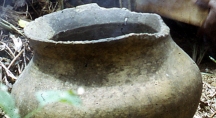 |
Having many children is an obligation, and a person’s status is increased by having more children. God is all important, so S/He would not be reduced to having only one child. The missionaries, of course, saw it differently, seeking exclusivity against the other deities.
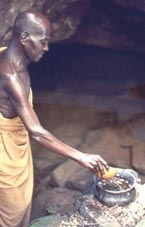 |
Pouring a libation to the powerful tutelary spirit, Nansing, a River inside a Cave
The missionaries soon recognised that there was also a different kind of sacred, that of the chiefs and elders who were the living physical manifestations of their own matrilineal ancestors. Not only were many of the missionaries teetotallers, they objected on theological grounds to the custom of pouring alcohol on the ground, like the pre Christian Greeks, as a gift and recognition of the ancestors and gods. To build a mission they were obligated to take a bottle of schnapps to the chief's court, to pour to the Gods and Ancestors, asking their permission for the endeavour.
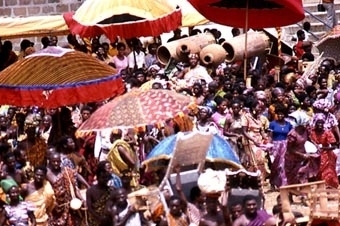 |
The Paramount Chief carried on palanquin in front of his drums
(Daasebre Akuamoah Boateng II)
The drums particularly brought fear into the hearts of the missionaries, and they saw the drums as being like an opiate or hypnotic, addicting the followers of this devil worship, and putting people into trances which negated their desire to see the people all become Christian converts in their version of Christianity. Today there are still many congregations which still forbid bringing drums into the church, in opposition to those who wish to Africanise Christian worship and don’t see drums as being inhabited by devils.
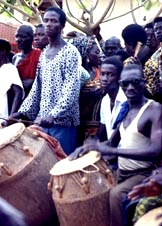 |
In contrast, many modern missionaries see the spiritual value of the drums. They remark that Christianity picked up many pagan customs when it went to Europe, such as Easter eggs and Christmas trees, so why shouldn't it add drums? Then the resistance came from members of the congregations who were converted by the earlier missionaries, still fearing the drums as the instruments of the devil.
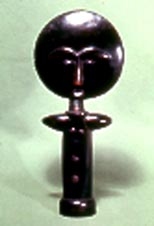 |
Akuaba fertility doll
The gods and ancestors also inhabited manufactured objects. Deities were seen to be in images and statues usually kept in sacred rooms set aside for gods, usually in the homes of the priests and priestesses. The ancestors of chiefs and elders were in specific stools which were kept in sacred ancestral rooms, usually in the chief’s palace or the houses of the oldest lines of each matrilineage.
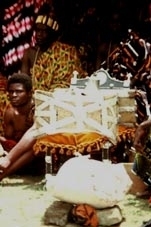 |
The ancestral blackened stool is hidden inside the white cloth on the stones
The ship's bell was a popular trophy during wars
In my paper on the three basic colours, the gods belong to the white sacred category while the ancestors belong to the black sacred category.
For the most part, the gods, priests and priestesses concern themselves with health and well being (physical, emotional, mental) and fertility. Conversely, elders, chiefs and ancestors are concerned mainly with political issues, deciding cases and resolving conflicts.
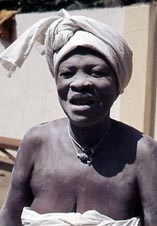 |
Nana Akonnedi Komfo dressed for Odwira ritual
I am writing some illustrated essays to expand this, some on elders and ancestors, others on priests and gods. You can see them by linking to them from below.
There is another category of spirits which can inhabit humans and objects. This is a range of elves, dwarves, powers (lacking personalities), sprites and things called "witches" (bayi, not to be confused with the European pagan religion of Wicca). These are not part of the major cosmography of the three colours, do not usually appear as important parts of the social organisation, and are usually associated with negative things, such as bad luck, misfortune, and evil spirits that are to be defeated by the gods.
Dwarves (moetia) appear to be beings in the collective conscious who represent forest dwellers, hunters and gatherers, related to the extant pygmies and Khoisan who are descendants of inhabitants of Africa prior to the expansion of the blacks. They are said to be coloured "red" and that their knees are on backwards. Often small gifts of fruit and other vegetarian fare are placed outside to placate and pacify them and ensure that they will not come and cause small mischief around the farms and houses, like gremlins and hobgoblins of European origin. (Recall "trick or treat" on October 31 in Canada).
Witches (bayi) appear mainly as waves of social hysteria, and are associated with various witch hunting cults, like Tigare, which are seen as witch hunting spirits brought from the North by enterprising southerners. The usual victims are old, neurotic and lonely women who are enticed to confess to being inhabited by a witch, and then undergo a cleansing organised by the carrier of the witch hunting spirit. Prior to Kwawu becoming a British Protectorate (1883), some of these cults required the victim to commit suicide so as to separate their soul from the evil spirit. Since then, the cleansing rite usually involves some sort of a bath, avoidance of certain foods, and regular donations to the witch hunting cult executives. If you travel to the village of the origin of such cults, the local god, or a mispronunciation of its name, appears to be the origin, and its priest or priestess does not recognise the cult as it is practised in the south. There is a Tigare witch hunter in the dispersed Obo community, and he occasionally shows up for an afahye or Adae Kese.
 |
Tigare Witch Killer
The Tigare anti witch practitioner shown here wears black instead of white, wears a smock from Northern Ghana, wears a monkey skin executioner's hat, and carries a stone battle axe to kill evil spirits. He is shown here, at an afahye in Kwawu Tafo, blowing a whistle and playing the dawuru (gong gong). See: http://www.djembe.dk/no/18/28nttd.html.
An interesting form of witchcraft is called "Nzima Bayi," named after a semi Akanized Guan speaking coastal group near the Côte d’Ivoire border. As we would expect, no one in Nzima recognises practitioners of this cult. It is often used as an explanation by non Kwawu persons to explain how the many of the Kwawu are so rich. People have a hard time recognising that some people do well through hard work and crafty investment; so an evil spirit is invented as an explanation.
Just as you can go to a prison and find no guilty person inside, so you will never find a Kwawu person admitting that she or he practices Nzima Bayi, or anyone who can provide the services of Nzima Bayi.
The story is that a person will go to a medium of this Bayi and offer to make some important sacrifices in order to become rich. They will surely have to allow their sister or beloved matrilineage member to die. The case is sometimes rather Faustian, in that the perpetrator will also sacrifice her or his own future after death, and/or die young.
They make the sacrifice so that they become rich, can build a big house or several, and have many children. People who relate these rumours cite the large number of new, clean empty houses in Obo. My own research (Abstract) saw that as a result of cyclical migration and the almost universal desire to raise houses in the home town coupled with success in business. Detractors (outsiders) saw the emptiness as evidence of dead relatives sacrificed to Nzima Bayi.
 |
Obo has many new, clean and storied houses, some of which are empty most of the time
Discolourations on the road are evidence of construction and renovations.
I was in the compound of a local god in Obo when two young men from a nearby district came, initially claiming that they sought protection from bad luck, as they had failed several times in business. While discussing with the priest, they let it be known that they were willing to make a few necessary sacrifices in order to succeed in business. The priest became very angry and turfed them out immediately without ceremony. He then told me that it was an occupational problem for priests in Kwawu that outsiders are often seeking the origin of this mythical Nzima Bayi. "No priest" he said, "can condone such evil practices, and must defend his or her reputation against accusations of practising them." I will talk more about the roles and responsibilities of priests and priestesses in the papers supplementary to this one on gods.
The two major and important categories of spirits which can "possess" or inhabit humans and objects belong to those of the gods (white category) and the ancestors (black category), and clearly fit into the tricolour system I describe in Three Souls.
Files in the Religion set: |